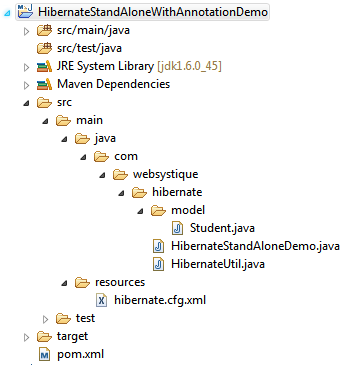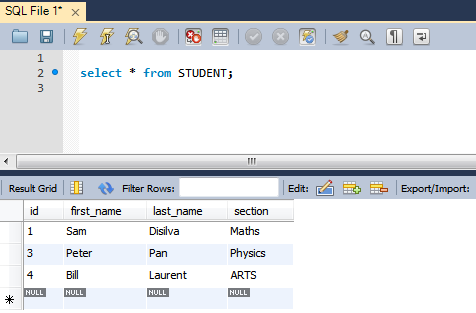In this tutorial, we will learn about how to use Hibernate to perform CRUD operations on database.
This example will make use of standard JPA annotations. Let’s get going.
“A short note : Java Persistence API (JPA) is a Standard Specification and Hibernate implements JPA specification. Hibernate also provides it’s own non-standard annotations to work with, but often it’s good practice to follow along with Standards and use standard annotations to make your code portable on other implementations.”
- Spring Boot+AngularJS+Spring Data+Hibernate+MySQL CRUD App
- Spring Boot REST API Tutorial
- Spring Boot WAR deployment example
- Spring Boot Introduction + Hello World Example
- Secure Spring REST API using OAuth2
- Spring 4 MVC+JPA2+Hibernate Many-to-many Example
- AngularJS+Spring Security using Basic Authentication
- Secure Spring REST API using Basic Authentication
- Spring 4 Caching Annotations Tutorial
- Spring 4 Cache Tutorial with EhCache
- Spring MVC 4+AngularJS Example
- Spring 4 Email Template Library Example
- Spring 4 Email With Attachment Tutorial
- Spring 4 Email Integration Tutorial
- Spring MVC 4+JMS+ActiveMQ Integration Example
- Spring 4+JMS+ActiveMQ @JmsLister @EnableJms Example
- Spring 4+JMS+ActiveMQ Integration Example
- Spring MVC 4+Hibernate Many-to-many JSP Example with annotation
- Spring MVC 4 HelloWorld – XML Example
- Spring MVC 4 HelloWorld – Annotation/JavaConfig Example
- Spring 4 HelloWorld – Annotation/JavaConfig Example
- Spring MVC 4+Hibernate 4+MySQL+Maven integration example
- Spring 4 + Hibernate 4 + MySQL+ Maven Integration example (Annotations+XML)
- Spring Security 4 Hello World Annotation+XML Example
- Spring Batch- MultiResourceItemReader & HibernateItemWriter example
- TestNG Hello World Example
- JAXB2 Helloworld Example
Following technologies being used:
- Hibernate 4.3.6.Final
- MySQL Server 5.6
- Maven 3.1.1
- JDK 1.6
- Eclipse JUNO Service Release 2
Let’s begin.
Step 1: Create required Database Table
Open MySQL terminal / workbench terminal and execute following MySQL script :
create table STUDENT ( id INT NOT NULL auto_increment PRIMARY KEY, first_name VARCHAR(30) NOT NULL, last_name VARCHAR(30) NOT NULL, section VARCHAR(30) NOT NULL );
Please visit MySQL installation on Local PC in case you are finding difficulties in setting up MySQL locally.
Step 2: Create project directory structure
Post Creating a maven project with command line contains step-by-step instruction to create a maven project with command line and importing to eclipse.
Following will be the final project structure:

Now let’s add/update the content mentioned in above project structure.
Step 3: Update pom.xml to include required Hibernate and MySQL dependency
Following is the updated minimalistic pom.xml
<project xmlns="http://maven.apache.org/POM/4.0.0" xmlns:xsi="http://www.w3.org/2001/XMLSchema-instance"
xsi:schemaLocation="http://maven.apache.org/POM/4.0.0 http://maven.apache.org/xsd/maven-4.0.0.xsd">
<modelVersion>4.0.0</modelVersion>
<groupId>com.websystique.hibernate</groupId>
<artifactId>HibernateStandAloneWithAnnotationDemo</artifactId>
<version>1.0.0</version>
<packaging>jar</packaging>
<name>HibernateStandAloneWithAnnotationDemo</name>
<properties>
<hibernate.version>4.3.6.Final</hibernate.version>
<mysql.connector.version>5.1.31</mysql.connector.version>
</properties>
<dependencies>
<!-- Hibernate -->
<dependency>
<groupId>org.hibernate</groupId>
<artifactId>hibernate-core</artifactId>
<version>${hibernate.version}</version>
</dependency>
<!-- MySQL -->
<dependency>
<groupId>mysql</groupId>
<artifactId>mysql-connector-java</artifactId>
<version>${mysql.connector.version}</version>
</dependency>
</dependencies>
<build>
<pluginManagement>
<plugins>
<plugin>
<groupId>org.apache.maven.plugins</groupId>
<artifactId>maven-compiler-plugin</artifactId>
<version>3.2</version>
<configuration>
<source>1.6</source>
<target>1.6</target>
</configuration>
</plugin>
</plugins>
</pluginManagement>
</build>
</project>
On saving pom.xml with above content, Eclipse will download all the dependencies.
Step 4: Create Model class
Model class Student is a simple POJO class which is annotated with JPA annotations to map it to a database table(created is step 1).
package com.websystique.hibernate.model;
import java.io.Serializable;
import javax.persistence.Column;
import javax.persistence.Entity;
import javax.persistence.GeneratedValue;
import javax.persistence.GenerationType;
import javax.persistence.Id;
import javax.persistence.Table;
@Entity
@Table(name = "STUDENT")
public class Student implements Serializable {
@Id
@GeneratedValue(strategy = GenerationType.IDENTITY)
private int id;
@Column(name = "FIRST_NAME", nullable = false)
private String firstName;
@Column(name = "LAST_NAME", nullable = false)
private String lastName;
@Column(name = "SECTION", nullable = false)
private String section;
public int getId() {
return id;
}
public void setId(int id) {
this.id = id;
}
public String getFirstName() {
return firstName;
}
public void setFirstName(String firstName) {
this.firstName = firstName;
}
public String getLastName() {
return lastName;
}
public void setLastName(String lastName) {
this.lastName = lastName;
}
public String getSection() {
return section;
}
public void setSection(String section) {
this.section = section;
}
@Override
public int hashCode() {
final int prime = 31;
int result = 1;
result = prime * result + id;
return result;
}
@Override
public boolean equals(Object obj) {
if (this == obj)
return true;
if (obj == null)
return false;
if (!(obj instanceof Student))
return false;
Student other = (Student) obj;
if (id != other.id)
return false;
return true;
}
@Override
public String toString() {
return "Student [id=" + id + ", firstName=" + firstName + ", lastName="
+ lastName + ", section=" + section + "]";
}
}
Above class uses standard JPA annotations.
@Entity marks this class as Entity Bean. @Table declares on which database Table this class will be mapped to.You can also specify other attributes like catalog and schema along with name. Note that @Table annotation is optional and in absence of this annotation, unqualified class name is used as table name in database.
@Id marks the field(or group of fields) as primary key of entity. Optionally, you can also specify how the primary key should be generated.This depends on the underlying database as well. For example, on MySQL ,IDENTITY is supported (strategy = GenerationType.IDENTITY) but not on Oracle. On the other hand Oracle supports sequence (strategy = GenerationType.SEQUENCE) but MySQL doesn’t.
@Column maps the class field to column name in database table.This too is optional and if not specified , field name will be used as column name.It You can specify other attributes including unique, nullable, name & length.
Finally, it’s a good practice to override hashcode and equals method. It becomes even mandatory when working with collections or detached instances. Hibernate manual contains a detailed description about them.
Step 5: Create Hibernate configuration file
We need to inform hibernate about how to connect to database, which database dialect we will be using so that hibernate can generate the instruction specific to that database.
We define all these information in hibernate.cfg.xml. Create this file with below content and save it in src/main/resources folder.
<?xml version="1.0" encoding="utf-8"?>
<!DOCTYPE hibernate-configuration SYSTEM "http://www.hibernate.org/dtd/hibernate-configuration-3.0.dtd">
<hibernate-configuration>
<session-factory>
<property name="hibernate.dialect">org.hibernate.dialect.MySQLDialect</property>
<property name="hibernate.connection.driver_class">com.mysql.jdbc.Driver</property>
<property name="hibernate.connection.username">myuser</property>
<property name="hibernate.connection.password">mypassword</property>
<property name="hibernate.connection.url">jdbc:mysql://localhost:3306/websystique</property>
<property name="show_sql">true</property>
<property name="format_sql">false</property>
<mapping class="com.websystique.hibernate.model.Student"/>
</session-factory>
</hibernate-configuration>
dialect property informs hibernate to generate database specific (MySQL here) instructions. driver_class defines the database specific driver hibernate will use to make connection. next 3 properties corresponds to database connection. show_sql will instruct hibernate to log all the statements on console and format_sql instructs it to display properly formatted sql. mapping tag instructs hibernate to perform mapping for classes refereed by class attribute.
Step 6: Create Hibernate Utility class
This class is well-known in hibernate community, and used for configuring hibernate on startup and managing session factory.Note that since we are using annotations, we have replaced Configurration with AnnotationConfiguration as shown below
package com.websystique.hibernate;
import org.hibernate.SessionFactory;
import org.hibernate.cfg.AnnotationConfiguration;
import com.websystique.hibernate.model.Student;
@SuppressWarnings("deprecation")
public class HibernateUtil {
private static final SessionFactory sessionFactory;
static{
try{
sessionFactory = new AnnotationConfiguration().configure().buildSessionFactory();
}catch (Throwable ex) {
System.err.println("Session Factory could not be created." + ex);
throw new ExceptionInInitializerError(ex);
}
}
public static SessionFactory getSessionFactory() {
return sessionFactory;
}
}
Step 7: Create executable class to Run and perform CRUD operations on Database
Put simply, Hibernate operations follow a pattern like:
Open session -> begin transaction -> do something with entities -> commit transaction
We will be using same pattern in our run class. Create a main class with below mentioned content and run it.
This class will save few records, list all of the persisted records from database, update a specific record in database and finally delete a specific record in database.
package com.websystique.hibernate;
import java.util.List;
import org.hibernate.Session;
import com.websystique.hibernate.model.Student;
/**
* Class used to perform CRUD operation on database with Hibernate API's
*
*/
public class HibernateStandAloneDemo {
@SuppressWarnings("unused")
public static void main(String[] args) {
HibernateStandAloneDemo application = new HibernateStandAloneDemo();
/*
* Save few objects with hibernate
*/
int studentId1 = application.saveStudent("Sam", "Disilva", "Maths");
int studentId2 = application.saveStudent("Joshua", "Brill", "Science");
int studentId3 = application.saveStudent("Peter", "Pan", "Physics");
int studentId4 = application.saveStudent("Bill", "Laurent", "Maths");
/*
* Retrieve all saved objects
*/
List<Student> students = application.getAllStudents();
System.out.println("List of all persisted students >>>");
for (Student student : students) {
System.out.println("Persisted Student :" + student);
}
/*
* Update an object
*/
application.updateStudent(studentId4, "ARTS");
/*
* Deletes an object
*/
application.deleteStudent(studentId2);
/*
* Retrieve all saved objects
*/
List<Student> remaingStudents = application.getAllStudents();
System.out.println("List of all remained persisted students >>>");
for (Student student : remaingStudents) {
System.out.println("Persisted Student :" + student);
}
}
/**
* This method saves a Student object in database
*/
public int saveStudent(String firstName, String lastName, String section) {
Student student = new Student();
student.setFirstName(firstName);
student.setLastName(lastName);
student.setSection(section);
Session session = HibernateUtil.getSessionFactory().openSession();
session.beginTransaction();
int id = (Integer) session.save(student);
session.getTransaction().commit();
session.close();
return id;
}
/**
* This method returns list of all persisted Student objects/tuples from
* database
*/
public List<Student> getAllStudents() {
Session session = HibernateUtil.getSessionFactory().openSession();
session.beginTransaction();
@SuppressWarnings("unchecked")
List<Student> employees = (List<Student>) session.createQuery(
"FROM Student s ORDER BY s.firstName ASC").list();
session.getTransaction().commit();
session.close();
return employees;
}
/**
* This method updates a specific Student object
*/
public void updateStudent(int id, String section) {
Session session = HibernateUtil.getSessionFactory().openSession();
session.beginTransaction();
Student student = (Student) session.get(Student.class, id);
student.setSection(section);
//session.update(student);//No need to update manually as it will be updated automatically on transaction close.
session.getTransaction().commit();
session.close();
}
/**
* This method deletes a specific Student object
*/
public void deleteStudent(int id) {
Session session = HibernateUtil.getSessionFactory().openSession();
session.beginTransaction();
Student student = (Student) session.get(Student.class, id);
session.delete(student);
session.getTransaction().commit();
session.close();
}
}
Below is the generated output of above program (set show_sql to false if you don’t want sql to be shown in output)
Hibernate: insert into STUDENT (FIRST_NAME, LAST_NAME, SECTION) values (?, ?, ?) Hibernate: insert into STUDENT (FIRST_NAME, LAST_NAME, SECTION) values (?, ?, ?) Hibernate: insert into STUDENT (FIRST_NAME, LAST_NAME, SECTION) values (?, ?, ?) Hibernate: insert into STUDENT (FIRST_NAME, LAST_NAME, SECTION) values (?, ?, ?) Hibernate: select student0_.id as id1_0_, student0_.FIRST_NAME as FIRST_NA2_0_, student0_.LAST_NAME as LAST_NAM3_0_, student0_.SECTION as SECTION4_0_ from STUDENT student0_ order by student0_.FIRST_NAME ASC List of all persisted students >>> Persisted Student :Student [id=4, firstName=Bill, lastName=Laurent, section=Maths] Persisted Student :Student [id=2, firstName=Joshua, lastName=Brill, section=Science] Persisted Student :Student [id=3, firstName=Peter, lastName=Pan, section=Physics] Persisted Student :Student [id=1, firstName=Sam, lastName=Disilva, section=Maths] Hibernate: select student0_.id as id1_0_0_, student0_.FIRST_NAME as FIRST_NA2_0_0_, student0_.LAST_NAME as LAST_NAM3_0_0_, student0_.SECTION as SECTION4_0_0_ from STUDENT student0_ where student0_.id=? Hibernate: update STUDENT set FIRST_NAME=?, LAST_NAME=?, SECTION=? where id=? Hibernate: select student0_.id as id1_0_0_, student0_.FIRST_NAME as FIRST_NA2_0_0_, student0_.LAST_NAME as LAST_NAM3_0_0_, student0_.SECTION as SECTION4_0_0_ from STUDENT student0_ where student0_.id=? Hibernate: delete from STUDENT where id=? Hibernate: select student0_.id as id1_0_, student0_.FIRST_NAME as FIRST_NA2_0_, student0_.LAST_NAME as LAST_NAM3_0_, student0_.SECTION as SECTION4_0_ from STUDENT student0_ order by student0_.FIRST_NAME ASC List of all remained persisted students >>> Persisted Student :Student [id=4, firstName=Bill, lastName=Laurent, section=ARTS] Persisted Student :Student [id=3, firstName=Peter, lastName=Pan, section=Physics] Persisted Student :Student [id=1, firstName=Sam, lastName=Disilva, section=Maths]
Below is the snapshot of MySQL database after execution of above program.

That’s it.
Download Source Code
References
If you like tutorials on this site, why not take a step further and connect me on Facebook , Google Plus & Twitter as well? I would love to hear your thoughts on these articles, it will help improve further our learning process.